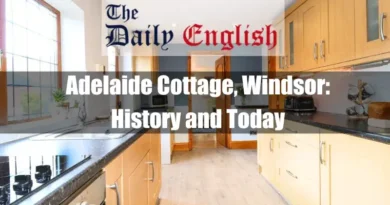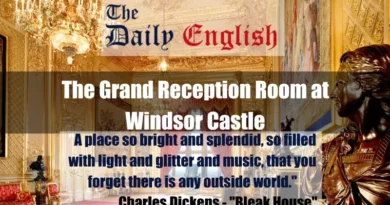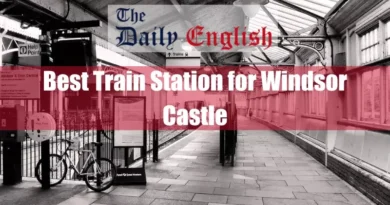I. Introduction
The Royal Great Kitchen at Windsor Castle is the oldest working kitchen in England, dating back to the reign of Edward III in the 1360s. It’s a large room with enormous fireplaces and has been used to prepare meals for the British monarchs ever since. Today, visitors can take a special tour to see the original hearths, learn about the extravagant feasts of the past (like 30-course banquets!), and get a glimpse into how a working royal kitchen functions.
II. The Origins and Evolution of the Great Kitchen

The Royal Great Kitchen at Windsor Castle is a testament to centuries of culinary history. Its impressive size and enduring functionality speak volumes about the importance of food and sustenance within the royal household. This section delves into the origins of this grand kitchen, tracing its development from the reign of Edward III to the present day.
A. The Reign of Edward III: Building a Kitchen for a King (1360s)
1. The Necessity of a Grand Kitchen
King Edward III, who reigned from 1327 to 1377, is credited with commissioning the construction of the Great Kitchen at Windsor Castle in the 1360s. Before this, royal kitchens were often smaller and dispersed throughout the castle complex. However, Edward III’s ambitions necessitated a dedicated space for his expansive court. His reign was marked by a period of relative peace and prosperity, allowing for a focus on lavish feasts and displays of royal power.
The growing size and sophistication of the royal court demanded a kitchen capable of feeding hundreds daily. Additionally, Edward III’s penchant for hosting grand banquets and diplomatic events further emphasised the need for a large, well-equipped kitchen. Historical records from the period mention feasts attended by hundreds of guests, with elaborate menus featuring multiple courses of meat, poultry, fish, and sweet delicacies.
2. Architectural Design and Influences
The design of the Great Kitchen reflects the architectural trends of the period, incorporating elements of medieval military architecture. The massive stone walls, high ceilings, and large fireplaces were not only functional but also served to create an imposing space that conveyed the power and grandeur of the monarchy.
Historians believe that Edward III’s experiences influenced the design of the Great Kitchen during the Hundred Years’ War (1337-1453). Some architectural features, like the large hearths, resemble those found in military kitchens capable of feeding large armies on the move. However, the Great Kitchen was not merely a utilitarian space. Its grand scale and imposing presence also reflected the king’s desire to showcase his wealth and power. The sheer size of the kitchen, with its towering chimneys and vast fireplaces, would have symbolised the monarch’s ability to provide for a large court and host impressive gatherings.
Beyond military influences, the design likely incorporated elements of contemporary domestic kitchens of the nobility. Large open hearths with roasting spits were common features in manor houses, and the Great Kitchen would have employed similar technologies on a grander scale.
| Category | Statistic | Time Period | Source |
|---|---|---|---|
| Daily Food Consumption | 500-1000 people | 14th-16th Centuries | Historical accounts of royal feasts, estimated court sizes |
| Daily Food Consumption | 200-500 people | 17th-19th Centuries | Historical accounts, estimated decline in court size |
| Staff Levels | 30-50 | 14th-16th Centuries | Historical records (possible payroll documents), expert estimations |
| Staff Levels | 20-30 | 17th-19th Centuries | Historical records, estimated decrease in kitchen activity |
| Hearths | 5-6 | Throughout History | Architectural plans, historical descriptions |
| Ovens | 2-3 | Throughout History | Architectural plans, historical descriptions |
Disclaimer: Due to the nature of historical records, these statistics are estimations based on available information and may not be entirely precise.
Also, read:
- Adelaide Cottage Interiors: Unveiling the Mysteries
- The Grand Reception Room at Windsor Castle
- The Queen’s Gallery at Windsor Castle
- The Crimson Drawing Room at Windsor Castle
III. Unveiling the Architecture and Features
Stepping into the Great Kitchen is like stepping back in time. The sheer size and imposing architecture create a sense of awe. At the same time, the meticulously preserved features tell stories of centuries of culinary activity. This section delves into the architectural details and key features that define the functionality and atmosphere of this historic space.
A. A Grand Design: Layout and Functionality
The Great Kitchen is rectangular, with a soaring ceiling supported by massive wooden beams. The layout is designed for efficiency, with dedicated areas for different food preparation and cooking stages.
1. The Imposing Hearths: Centerpieces of Culinary Power
Undoubtedly, the most striking feature of the Great Kitchen is its collection of enormous hearths. These colossal fireplaces, built from brick and stone, dominated the room and served as the primary source of heat for cooking.
Multiple hearths were typically present, each with its purpose. Some had large spits for roasting whole animals like oxen or boar, while others featured grates for pots and pans simmering stews or sauces. The sheer size of the hearths allowed for cooking vast quantities of food simultaneously, catering to the needs of a large royal household. The constant glow of the fires and the rhythmic crackle of burning wood would have been a defining characteristic of the kitchen environment.
2. Ovens, Rotisseries, and Other Cooking Equipment
Beyond the hearths, the Great Kitchen housed various specialised cooking equipment. Large brick ovens were used for baking bread, pastries, and pies. Powered by cranks or water wheels, rotisseries allowed continuous meat roasting. Cauldrons suspended over the fires simmered soups and stews. Additionally, various smaller tools like mortars and pestles, chopping blocks, and knives would have been used for food preparation.
3. Storage and Preparation Spaces: A Beehive of Activity
The Great Kitchen was not just a cooking space but a bustling activity centre. Dedicated areas were allocated for food storage and preparation. Pantries stocked with provisions like flour, spices, and dried goods lined the walls. Large wooden tables provided ample space for chopping vegetables, preparing meat, and assembling dishes. The constant movement of staff cleaning, prepping, and cooking would have created a vibrant and energetic atmosphere.
Also, read:
B. Beyond Cooking: Additional Features of the Great Kitchen
While the focus was undoubtedly on cooking, the Great Kitchen also incorporated additional features essential for its daily operation.
1. The Lantern: Providing Light and Ventilation
A large lantern, often a central feature of the high ceiling, provided much-needed illumination during the day. Additionally, strategically placed vents and openings helped clear smoke and heat generated by the enormous hearths.
2. Service Passages and Food Transportation
Connecting the Great Kitchen to the State Apartments were dedicated service passages. These passages facilitated efficiently transporting prepared dishes to the royal dining halls. Elaborate protocols likely existed for food movement, ensuring its arrival at the correct temperature and presentation.
3. Staff Quarters and Working Conditions
The Great Kitchen housed the vast kitchen staff’s cooking space and living quarters. These quarters, likely above or adjacent to the main kitchen area, would have been basic but functional. The working conditions in the Great Kitchen were undoubtedly demanding. The intense heat from the fires, the constant activity, and the long hours would have taken a toll on the staff. However, working in the royal kitchen also presented opportunities for advancement and a sense of pride in serving the monarchy.
Also, read:
IV. Fueling the Royals: Food, Feasts, and Culinary Delights

The Great Kitchen wasn’t just a room filled with impressive architecture; it was the beating heart of the royal culinary experience. This section delves into the fascinating world of food within the castle walls, exploring how the kitchen sourced its provisions and catered to the ever-evolving tastes of the monarchs.
A. A Glimpse into the Royal Pantry: Sourcing Ingredients and Provisions
Feeding a royal court was no small feat. The Great Kitchen relied on a complex network of suppliers to keep its pantry stocked with a dazzling array of ingredients.
1. Royal Purveyors and Local Suppliers
A system of royal purveyors, individuals granted a special warrant to supply the royal household, played a crucial role. These purveyors, often skilled farmers, butchers, and fishmongers, were responsible for delivering high-quality meats, poultry, fish, and dairy products. They were held to strict standards, ensuring the freshness and quality of ingredients reaching the royal table.
Beyond royal purveyors, the kitchen relied on local suppliers for seasonal produce, herbs, and other necessities. Royal estates and surrounding villages likely contributed significantly to the kitchen’s needs. This network of suppliers ensured a steady stream of provisions and fostered economic activity in the surrounding region.
2. Stocking the Kitchen: The Diversity of Ingredients
The ingredients used in the Great Kitchen reflected the agricultural bounty of England and the growing influence of international trade. While staples like bread, meat, and vegetables formed the foundation of the royal diet, a surprising variety of other ingredients found their way into the kitchen.
- Meat and Poultry: Beef, pork, mutton, and chicken were all commonly consumed, with delicacies like swan, venison, and peacock reserved for special occasions.
- Fish and Seafood: Freshly caught fish from nearby rivers and the sea played a significant role in the royal diet. The nobility enjoyed shellfish, oysters, and even lobsters.
- Fruits and Vegetables: Apples, pears, plums, and other seasonal fruits were featured in desserts and jams. Vegetables like peas, beans, carrots, and turnips formed part of savoury dishes.
- Spices and Herbs: Spices like pepper, cinnamon, ginger, and nutmeg were highly sought after and added exotic flavours to royal dishes. Fresh herbs grown in royal gardens or sourced locally added depth and complexity to stews and sauces.
This rich tapestry of ingredients allowed the royal chefs to create a diverse and flavorful culinary experience for the monarchs and their guests.
Also, read:
- Windsor Castle Opening Times: Everything You Need to Know.
- Windsor Castle Tickets: A Proven Comprehensive Guide.
- Windsor Castle Changing of the Guard: Where History Coming Alive.
- Windsor Castle Tour: A Comprehensive and Best Guide.
- Windsor Castle Tickets Advantage Card: Know Everything.
V. The Workings of the Great Kitchen
The Great Kitchen wasn’t just a grand space; it was a beehive of activity fueled by a dedicated staff working tirelessly to feed the royal court. This section delves into the daily rhythm of the kitchen, exploring the various roles and responsibilities that ensured the smooth operation of this vital department.
A. From Dawn to Dusk: The Daily Routine and Rhythm
The day in the Great Kitchen began well before the first rays of dawn.
Fire Maintenance and Kitchen Preparation: Skilled stokers ensured the enormous hearths were lit and maintained at a consistent temperature throughout the day. Other staff cleaned the kitchen space, prepared chopping blocks and utensils, and laid out the necessary tools for the upcoming culinary tasks.
Food Preparation and Cooking Processes: A flurry of activity commenced with the fires roaring and the kitchen prepped. Butchers prepared cuts of meat, vegetable peelers tackled mountains of fresh produce, and skilled cooks began the process of simmering stews, roasting meats, and baking bread. The exact tasks would vary depending on the planned menus and upcoming events.
Meal Service and Coordination with the State Apartments: A well-rehearsed dance of preparation and service unfolded as lunchtime neared. Dishes were meticulously plated, inspected for presentation, and carefully transported through dedicated service passages to the State Apartments. This ensured the food arrived hot and fresh for the royal family and their guests.
This rigorous schedule continued throughout the day, with additional cooking spurts for dinner and potentially even a late-night supper. The Great Kitchen was a machine in constant motion, fueled by the tireless efforts of its staff.
Also, read:
- Exploring Buckingham Palace to Windsor Castle Journey.
- How Far is Windsor Castle from Buckingham Palace? Royal Mile?
- How to Get to the Windsor Castle from London
B. The Hierarchy of the Kitchen: Roles and Responsibilities
The smooth operation of the Great Kitchen relied on a well-defined hierarchy, with each member playing a crucial role.
- The Master Chef: At the pinnacle stood the Master Chef, a highly skilled individual responsible for overseeing all culinary operations. The Master Chef planned menus, managed the staff, and ensured the quality and presentation of all dishes. They were often chosen for their extensive culinary knowledge, leadership skills, and ability to manage a large staff.
- Skilled Cooks and Kitchen Staff: Beneath the Master Chef, a team of skilled cooks with specialised skills carried out the daily tasks. Roasters managed the roasting spits, pastry chefs created elaborate desserts, and sauciers prepared complex sauces and gravies. These skilled individuals formed the backbone of the kitchen. They were responsible for the actual preparation and cooking of the food.
- Apprentices and the Learning Process: The apprentice system was a crucial element of the kitchen hierarchy. Young boys, often from local villages, were taken on as apprentices and trained in the various culinary arts. They started with basic tasks like cleaning vegetables. They progressed to more complex cooking techniques under the guidance of experienced chefs. This system ensured a continuous stream of skilled kitchen staff and perpetuated the culinary traditions of the royal household.
The complex interplay of these roles within the Great Kitchen fostered a sense of teamwork and a shared purpose. From the Master Chef’s leadership to the apprentices’ eagerness to learn, every member contributed to the success of this vital royal department.
Also, read:
- Who Lives in the Windsor Castle?
- Are Babies Free for Windsor Castle
- Are Dogs Allowed into Windsor Castle
VI. The Great Kitchen in the Modern World

The Great Kitchen at Windsor Castle is a testament to centuries of culinary history. Though its primary function of feeding a vast royal court has diminished, the kitchen plays a significant role in the modern era. This section delves into the contemporary purpose of the Great Kitchen, highlighting its ongoing relevance and efforts to preserve this culinary landmark.
A. The Role of the Great Kitchen Today: Beyond Royal Feasts
While the Great Kitchen no longer caters to hundreds daily, it still serves a vital purpose within the royal household.
State Banquets and Special Events: The Great Kitchen is occasionally used to prepare food for state banquets and other special events held at Windsor Castle. On these occasions, skilled chefs showcase their culinary talents, often incorporating traditional recipes and techniques alongside modern flourishes. The Great Kitchen’s historical setting adds grandeur and significance to these prestigious events.
Educational Tours and Public Engagement: The Great Kitchen has become a popular feature of tours offered at Windsor Castle. Visitors can gain a fascinating glimpse into this iconic space’s history, architecture, and daily operations. Interactive exhibits and informative guides bring the kitchen’s story to life, fostering public interest in royal history and culinary traditions.
The shift towards public education and showcasing the kitchen’s historical significance has broadened the reach and impact of the Great Kitchen. It’s no longer just a place for cooking royal meals but a platform for historical education and cultural appreciation.
B. Preservation and Restoration: Safeguarding a Culinary Landmark
The Great Kitchen’s enduring legacy necessitates ongoing efforts to preserve its architectural features and historical integrity.
Ongoing Maintenance and Conservation Efforts: The Royal Collection Trust, the organisation responsible for the upkeep of royal palaces, undertakes regular maintenance and conservation work on the Great Kitchen. This includes tasks like repairing the stonework, cleaning the hearths, and ensuring the structural integrity of the building.
The Importance of Preserving Culinary Heritage: The Great Kitchen isn’t just a building; it’s a tangible link to centuries of culinary history. By preserving it, we safeguard valuable knowledge and traditions related to royal cuisine. Additionally, the kitchen serves as a reminder of the evolution of foodways and cooking techniques in England.
The meticulous preservation efforts ensure that the Great Kitchen continues to stand as a vibrant symbol of culinary heritage, not just for the British monarchy but for the broader public.
Also, read:
- Comparing Shops Near Windsor Castle
- The Mystery of 2 Windsor Castles
- Are There Guided Tours of Windsor Castle
- Are There Mice in Windsor Castle
VII. The Great Kitchen in Literature and Art

The Great Kitchen at Windsor Castle isn’t just a physical space; it’s a place woven into the fabric of British history and culture. Its imposing presence and rich history have captured the imagination of writers and artists for centuries. This section delves into how the Great Kitchen has been depicted in literature and art, becoming a symbol of royal power, culinary innovation, and the bustling heart of the castle.
A. Literary Depictions: Bringing the Kitchen to Life
The Great Kitchen has found its way into various forms of literature, offering a glimpse into its past purpose and the lives of those who worked within its walls.
Historical Accounts and Royal Diaries: Historical accounts and even personal diaries of monarchs and courtiers often mention the Great Kitchen, detailing the scale of operations, the types of food prepared, and the importance of lavish feasts in showcasing royal power. These accounts provide valuable insights into the kitchen’s role in court life and the impact of food on social and political events.
Fictional Representations and Culinary Inspiration: Fictional works in historical periods often feature the Great Kitchen as a backdrop for intrigue, romance, and social hierarchy stories. Authors might depict the daily routines of the kitchen staff, the power dynamics between chefs and apprentices, or the pressure to create an elaborate feast to impress a visiting dignitary. These fictional representations bring the Great Kitchen to life for readers and tap into the enduring fascination with royal life and historical culinary traditions.
The Great Kitchen has also served as a source of inspiration for cookbooks. Historical recipes, gleaned from royal archives or descriptions in literature, can be adapted for modern kitchens, offering a taste of the past and a connection to the culinary heritage embodied by the Great Kitchen.
B. Artistic Interpretations: Capturing the Kitchen on Canvas
The Great Kitchen’s visual grandeur has also inspired artists for centuries.
Early Depictions and Architectural Renderings: Early depictions of the Great Kitchen might be found in architectural renderings or illustrations accompanying historical texts. While only sometimes detailed, these images provide valuable clues about the kitchen’s layout, design features, and overall scale.
Paintings and Illustrations of Kitchen Life: Artists have also attempted to capture the bustling activity and atmosphere within the Great Kitchen. Paintings or illustrations showcase the roaring fires, chefs at work, or the transportation of finished dishes. These artistic interpretations illuminate the kitchen walls’ daily operations and working conditions.
The Great Kitchen’s presence in literature and art reinforces its significance beyond its historical function. It becomes a symbol of a bygone era, a testament to culinary artistry, and a reminder of the importance of food in shaping social interactions and cultural narratives.
Also, read:
- Are There Stables at Windsor Castle
- Are There Steps, Elevators or Lifts in Windsor Castle
- Are There Women in the Coldstream Guards at Windsor Castle
- What Does Buckingham Palace Look Like?
- How Deep is the River Thames? Exposing the River Thames.
VIII. Conclusion
The Great Kitchen at Windsor Castle is a remarkable testament to the enduring power of food and its role in shaping history. From its construction in the reign of Edward III to its modern-day use for state banquets and educational tours, the kitchen has witnessed centuries of culinary evolution, evolving alongside the changing tastes and needs of the monarchy.
The Great Kitchen’s significance goes beyond its architectural marvel. It’s a tangible link to the past, offering a glimpse into royal life, culinary traditions, and the intricate social hierarchy within the castle walls. By preserving this historic space and sharing its story with the public, we ensure that the legacy of the Great Kitchen continues to inspire and educate future generations, solidifying its place as a unique and enduring landmark within British history and culture.









